Multiple Dimensions of Smart Cities’ Infrastructure: A Review
Abstract
1. Introduction
- Infrastructure development using smart systems;
- Information and Communications Technology (ICT) and its role in infrastructure construction, management, maintenance and operation;
- Sustainability in current smart infrastructure.
- What are the various dimensions that smart city infrastructure research focuses on?
- What are the research themes and classes associated with these dimensions?
- What are the main shortcomings of current approaches, and what would be a good research agenda for the future in smart infrastructure?
2. Materials and Methods
- Step 1: Collection of relevant materials.
- Step 2: Descriptive analysis of the examined literature.
- Step 3: Presentation of a classification framework categorizing the smart city infrastructure studies examined.
- Step 4: Evaluation of the material identified in Step 1, based on the classification framework developed in Step 3.
2.1. Collection of Relevant Materials
2.1.1. Scopus
- The “smart city” term was used in the “title” and “abstract” fields. The research was limited to the last 8 years (2014–2021), to article and book chapters (as document types), and to the English language. A total of 8370 documents were retrieved.
- The “smart city” and “infrastructure” terms were used in the “title” and “abstract” fields. The research was limited to the last 8 years (2014–2021), to article and book chapters (as document types), and to the English language. A total of 1556 documents were retrieved.
- The “urban systems” and “development” terms were used in the “title” and “abstract” fields. The research was limited to the last 8 years (2014–2021), to article and book chapters (as document types), and to the English language. A total of 720 documents were retrieved.
- The “smart city”, “network” and “system” terms were used in the “title” and “abstract” fields. The research was limited to the last 8 years (2014–2021), to article and book chapters (as document types), and to the English language. A total of 1956 documents were retrieved.
- The “urban systems”, “infrastructure” and “sustainability” terms were used in the “title” and “abstract” fields. The research was limited to the last 8 years (2014–2021), to article and book chapters (as document types), and to the English language. A total of 64 documents were retrieved.
- The “citizen”, “government” and “ICT” terms were used in the “title” and “abstract” fields. The research was limited to the last 8 years (2014–2021), to article and book chapters (as document types), and to the English language. A total of 417 documents were retrieved.
2.1.2. IEEE Xplore
- The “smart city” term was used in the “abstract” field. The research was limited to the last 8 years (2014–2021) and to books, journals, and conferences (as document types). A total of 3199 documents were retrieved.
- The “smart city” and “infrastructure” terms were used in the “abstract” field. The research was limited to the last 8 years (2014–2021) and to books, journals, and conferences (as document types). A total of 656 documents were retrieved.
- The “urban systems” and “development” terms were used in the “abstract” field. The research was limited to the last 8 years (2014–2021) and to books, journals, and conferences (as document types). A total of 785 documents were retrieved.
- The “smart city”, “network” and “system” terms were used in the “abstract” field. The research was limited to the last 8 years (2014–2021) and to books, journals, and conferences (as document types). A total of 1054 documents were retrieved.
- The “urban system”, “infrastructure” and “sustainability” terms were used in the “abstract” field. The research was limited to the last 8 years (2014–2021) and to books, journals, and conferences (as document types). A total of 1 document was retrieved.
- The “citizen”, “government” and “ICT” terms were used in the “abstract” field. The research was limited to the last 8 years (2014–2021) and to books, journals, and conferences (as document types). A total of 8 documents were retrieved.
2.1.3. Emerald Insight
- The “smart city” term was used in the “abstract” field. The research was limited to the last 8 years (2014–2021) and to articles and chapters. A total of 206 documents were retrieved.
- The “smart city” and “infrastructure” terms were used in the “abstract” field. The research was limited to the last 8 years (2014–2021) and to articles and chapters. A total of 279 documents were retrieved.
- The “urban systems” and “development” terms were used in the “abstract” field. The research was limited to the last 8 years (2014–2021) and to articles and chapters. A total of 84 documents were retrieved.
- The “smart city”, “network” and “system” terms were used in the “abstract” field. The research was limited to the last 8 years (2014–2021) and to articles and chapters. A total of 311 documents were retrieved.
- The “urban systems”, “infrastructure” and “sustainability” terms were used in the “search term” field. The research was limited to the last 8 years (2014–2021) and to articles and chapters. A total of 2 documents were retrieved.
- The “citizen”, “government” and “ICT” terms were used in the “search term” field. The research was limited to the last 8 years (2014–2021) and to articles and chapters. A total of 167 documents were retrieved.
2.2. Descriptive Analysis of the Materials
2.3. Analysis of Papers
2.4. Smart Cities’ Infrastructure Research Dimensions and Themes
3. Results and Discussion
- Smart city network architecture covers papers regarding the installation of sensors throughout the city for diverse reasons [139], including big data analysis of urban systems to enhance their performance [140], communications technology, and mobile signal. There is also the issue of fragmented infrastructure [67].
- Health-themed studies focus on automated tools and technology embedded in the infrastructure for diagnosing defects, structural issues and maintenance requirements [141].
- Lastly, under the population theme, articles that discuss smart communities (e.g., their participation in key decision-making regarding infrastructure systems, or enhancing their contributions via user-centric approaches) are categorized [146]. Studies that motivate citizens by utilizing transparent and accessible management models of smart city infrastructure are also grouped under this theme.
- A more comprehensive understanding of the impacts of socio-technological practices on the future roadmap of smart city infrastructure development is needed.
- Most of the studies tend to focus on how to transform, ameliorate or create smart infrastructure and do not necessarily sufficiently tackle the issue of how to maintain and conserve it.
- Topics that collectively examine how smart infrastructure impacts economic growth and politics in the region are rare. There is an urgent need for studies that evaluate the realization of these aspects through quantitative comparisons or in-depth case analysis.
- Smart city infrastructure must be conceptualized as an emergent socio-technological topic that will only be fully understood if a comprehensive view is studied and well-contextualized, such that Frankenstein urbanism is avoided.
- Future studies must focus on both the transformation and subsequent maintenance of urban infrastructure. Most current studies focus on one of these without exploring the other. Empirical research needs to done to investigate what is required in order to conserve everything well.
- Sound evaluation studies of the impact of smart city infrastructure on economic growth and politics are necessary. The underlying assumption is that a smart city makes life better for everyone, and there is a lack of attention to the politics of technical choices. Artifacts do have politics. Specific choices about (technological) infrastructure have consequences for power distribution in the city—and thus need to be studied accordingly.
- Scaling up the search for socio-technological synergy—from the level of enterprises and organizations in general to the level of urban systems—has merits. However, research into these issues must avoid oversimplifying the new connections between technology, government, and population. Research into smart city infrastructure and its governance must learn from the success of factors already identified for e-government and build upon it. It should consider existing theories of socio-technological transformation and study urban systems’ development as an evolving process of institutional change.
4. Conclusion and Future Direction
Author Contributions
Funding
Institutional Review Board Statement
Informed Consent Statement
Data Availability Statement
Conflicts of Interest
References
- Founoun, A. Evaluation of the concept of the smart city through local regulation and the importance of local initiative. In Proceedings of the 2018 IEEE International Smart Cities Conference (ISC2), Kansas City, MO, USA, 16–19 September 2018; pp. 1–6. [Google Scholar]
- Xie, Y.; Gupta, J.; Li, Y.; Shekhar, S. Transforming Smart Cities with Spatial Computing. In Proceedings of the 2018 IEEE International Smart Cities Conference, ISC2, Kansas City, MO, USA, 16–19 September 2018; Institute of Electrical and Electronics Engineers Inc.: New York, NY, USA, 2019. [Google Scholar]
- Marrone, M.; Hammerle, M. Smart Cities: A Review and Analysis of Stakeholders’ Literature. Bus. Inf. Syst. Eng. 2018, 60, 197–213. [Google Scholar] [CrossRef]
- Ota, K.; Kumrai, T.; Dong, M.; Kishigami, J.; Guo, M. Smart Infrastructure Design for Smart Cities. IT Prof. 2017, 19, 42–49. [Google Scholar] [CrossRef]
- Khan, S.M.; Chowdhury, M.; Morris, E.A.; Deka, L. Synergizing Roadway Infrastructure Investment with Digital Infrastructure: Motivations, Current Status and Future Direction. ASCE J. Infrastruct. Syst. 2019, 25, 03119001. [Google Scholar] [CrossRef]
- Berglund, E.Z.; Monroe, J.G.; Ahmed, I.; Noghabaei, M.; Do, J.; Pesantez, J.E.; Khaksar Fasaee, M.A.; Bardaka, E.; Han, K.; Proestos, G.T.; et al. Smart Infrastructure: A Vision for the Role of the Civil Engineering Profession in Smart Cities. J. Infrastruct. Syst. 2020, 26, 03120001. [Google Scholar] [CrossRef]
- Bhushan, B.; Khamparia, A.; Sagayam, K.M.; Sharma, S.K.; Ahad, M.A.; Debnath, N.C. Blockchain for smart cities: A review of architectures, integration trends and future research directions. Sustain. Cities Soc. 2020, 61, 102360. [Google Scholar] [CrossRef]
- Anthony Jnr, B. Managing digital transformation of smart cities through enterprise architecture—A review and research agenda. Enterp. Inf. Syst. 2020, 1–33. [Google Scholar] [CrossRef]
- Talari, S.; Shafie-Khah, M.; Siano, P.; Loia, V.; Tommasetti, A.; Catalão, J.P.S. A review of smart cities based on the internet of things concept. Energies 2017, 10, 421. [Google Scholar] [CrossRef]
- Lai, C.S.; Jia, Y.; Dong, Z.; Wang, D.; Tao, Y.; Lai, Q.H.; Wong, R.T.K.; Zobaa, A.F.; Wu, R.; Lai, L.L. A Review of Technical Standards for Smart Cities. Clean Technol. 2020, 2, 290–310. [Google Scholar] [CrossRef]
- Silva, B.N.; Khan, M.; Han, K. Towards sustainable smart cities: A review of trends, architectures, components, and open challenges in smart cities. Sustain. Cities Soc. 2018, 38, 697–713. [Google Scholar] [CrossRef]
- Ruhlandt, R.W.S. The governance of smart cities: A systematic literature review. Cities 2018, 81, 1–23. [Google Scholar] [CrossRef]
- Cugurullo, F. Urban Artificial Intelligence: From Automation to Autonomy in the Smart City. Front. Sustain. Cities 2020, 2, 1–14. [Google Scholar] [CrossRef]
- Jayasena, N.S.; Chan, D.W.M.; Kumaraswamy, M. A systematic literature review and analysis towards developing PPP models for delivering smart infrastructure. Built Environ. Proj. Asset Manag. 2020. [Google Scholar] [CrossRef]
- Bolívar, M.P.R.; Meijer, A.J. Smart Governance: Using a Literature Review and Empirical Analysis to Build a Research Model. Soc. Sci. Comput. Rev. 2016, 34, 673–692. [Google Scholar] [CrossRef]
- Mayring, P. Qualitative Inhaltsanalyse—Handbuch Qualitative Forschung: Grundlagen, Konzepte, Methoden und Anwendungen; Psychologie Verlagsunion: Weinheim, Germany, 1995. [Google Scholar]
- Ahuja, K.; Khosla, A. Network selection criterion for ubiquitous communication provisioning in smart cities for smart energy system. J. Netw. Comput. Appl. 2019, 127, 82–91. [Google Scholar] [CrossRef]
- Rego, A.; Garcia, L.; Sendra, S.; Lloret, J. Software Defined Network-based control system for an efficient traffic management for emergency situations in smart cities. Futur. Gener. Comput. Syst. 2018, 88, 243–253. [Google Scholar] [CrossRef]
- Pawłowicz, B.; Salach, M.; Trybus, B. Smart city traffic monitoring system based on 5G cellular network, RFID and machine learning. Adv. Intell. Syst. Comput. 2019, 830, 151–165. [Google Scholar]
- Ullah, I.; Baharom, M.N.R.; Ahmad, H.; Wahid, F.; Luqman, H.M.; Zainal, Z.; Das, B. Smart Lightning Detection System for Smart-City Infrastructure Using Artificial Neural Network. Wirel. Pers. Commun. 2019, 106, 1743–1766. [Google Scholar] [CrossRef]
- Chifor, B.-C.; Bica, I.; Patriciu, V.-V. Sensing service architecture for smart cities using social network platforms. Soft Comput. 2017, 21, 4513–4522. [Google Scholar] [CrossRef]
- Boukerche, A.; Coutinho, R.W.L.; Loureiro, A.A.F. Information-Centric Cognitive Radio Networks for Content Distribution in Smart Cities. IEEE Netw. 2019, 33, 146–151. [Google Scholar] [CrossRef]
- Julieta Cedillo-Elias, E.; Antonio Orizaga-Trejo, J.; Larios, V.M.; Maciel Arellano, L.A. Smart Government infrastructure based in SDN Networks: The case of Guadalajara Metropolitan Area. In Proceedings of the 2018 IEEE International Smart Cities Conference, ISC2, Kansas City, MO, USA, 16–19 September 2018; Institute of Electrical and Electronics Engineers Inc.: New York, NY, USA, 2018. [Google Scholar]
- Marques, P.; Manfroi, D.; Deitos, E.; Cegoni, J.; Castilhos, R.; Rochol, J.; Pignaton, E.; Kunst, R. An IoT-based smart cities infrastructure architecture applied to a waste management scenario. Ad Hoc Netw. 2019, 87, 200–208. [Google Scholar] [CrossRef]
- Sharma, P.K.; Rathore, S.; Park, J.H. DistArch-SCNet: Blockchain-Based Distributed Architecture with Li-Fi Communication for a Scalable Smart City Network. IEEE Consum. Electron. Mag. 2018, 7, 55–64. [Google Scholar] [CrossRef]
- Habibzadeh, H.; Boggio-Dandry, A.; Qin, Z.; Soyata, T.; Kantarci, B.; Mouftah, H.T. Soft Sensing in Smart Cities: Handling 3Vs Using Recommender Systems, Machine Intelligence, and Data Analytics. IEEE Commun. Mag. 2018, 56, 78–86. [Google Scholar] [CrossRef]
- Amini, M.H.; Boroojeni, K.G.; Iyengar, S.S.; Blaabjerg, F.; Pardalos, P.M.; Madni, A.M. A Panorama of future interdependent networks: From intelligent infrastructures to smart cities. Stud. Syst. Decis. Control. 2018, 145, 1–10. [Google Scholar]
- Jawhar, I.; Mohamed, N.; Al-Jaroodi, J. Networking architectures and protocols for smart city systems. J. Internet Serv. Appl. 2018, 9, 26. [Google Scholar] [CrossRef]
- Kunst, R.; Avila, L.; Pignaton, E.; Bampi, S.; Rochol, J. Improving network resources allocation in smart cities video surveillance. Comput. Netw. 2018, 134, 228–244. [Google Scholar] [CrossRef]
- Vlahogianni, E.I.; Kepaptsoglou, K.; Tsetsos, V.; Karlaftis, M.G. A Real-Time Parking Prediction System for Smart Cities. J. Intell. Transp. Syst. Technol. Plan. Oper. 2016, 20, 192–204. [Google Scholar] [CrossRef]
- Wu, S.M.; Chen, T.-C.; Wu, Y.J.; Lytras, M. Smart cities in Taiwan: A perspective on big data applications. Sustainbility 2018, 10, 106. [Google Scholar] [CrossRef]
- Li, M.; Si, P.; Zhang, Y. Delay-Tolerant Data Traffic to Software-Defined Vehicular Networks With Mobile Edge Computing in Smart City. IEEE Trans. Veh. Technol. 2018, 67, 9073–9086. [Google Scholar] [CrossRef]
- Liu, Y.; Weng, X.; Wan, J.; Yue, X.; Song, H.; Vasilakos, A.V. Exploring Data Validity in Transportation Systems for Smart Cities. IEEE Commun. Mag. 2017, 55, 26–33. [Google Scholar] [CrossRef]
- Zhu, Y.; Zuo, J. Research on security construction of smart city. Int. J. Smart Home 2015, 9, 197–204. [Google Scholar] [CrossRef][Green Version]
- Lu, W.; Gong, Y.; Liu, X.; Wu, J.; Peng, H. Collaborative Energy and Information Transfer in Green Wireless Sensor Networks for Smart Cities. IEEE Trans. Ind. Inform. 2018, 14, 1585–1593. [Google Scholar] [CrossRef]
- Ullah, R.; Faheem, Y.; Kim, B. Energy and Congestion-Aware Routing Metric for Smart Grid AMI Networks in Smart City. IEEE Access 2017, 5, 13799–13810. [Google Scholar] [CrossRef]
- Serrano, E.; Bajo, J. Deep neural network architectures for social services diagnosis in smart cities. Futur. Gener. Comput. Syst. 2019, 100, 122–131. [Google Scholar] [CrossRef]
- Green, R.B.; Guzman, M.; Izyumskaya, N.; Ullah, B.; Hia, S.; Pitchford, J.; Timsina, R.; Avrutin, V.; Ozgur, U.; Morkoc, H.; et al. Optically Transparent Antennas and Filters: A Smart City Concept to Alleviate Infrastructure and Network Capacity Challenges. IEEE Antennas Propag. Mag. 2019, 61, 37–47. [Google Scholar] [CrossRef]
- Guguloth, R.; Kumar, T.K.S. Congestion management in restructured power systems for smart cities in India. Comput. Electr. Eng. 2018, 65, 79–89. [Google Scholar] [CrossRef]
- Alavi, A.H.; Jiao, P.; Buttlar, W.G.; Lajnef, N. Internet of Things-enabled smart cities: State-of-the-art and future trends. Meas. J. Int. Meas. Confed. 2018, 129, 589–606. [Google Scholar] [CrossRef]
- Sumia, L.; Ranga, V. Intelligent traffic management system for prioritizing emergency vehicles in a smart city. Int. J. Eng. Trans. B Appl. 2018, 31, 278–283. [Google Scholar]
- Li, F.; Liu, X.; Zhang, X.; Zhao, D.; Liu, H.; Zhou, C.; Wang, R. Urban ecological infrastructure: An integrated network for ecosystem services and sustainable urban systems. J. Clean. Prod. 2017, 163, S12–S18. [Google Scholar] [CrossRef]
- Dhakal, K.P.; Chevalier, L.R. Managing urban stormwater for urban sustainability: Barriers and policy solutions for green infrastructure application. J. Environ. Manag. 2017, 203, 171–181. [Google Scholar] [CrossRef]
- Wei, J.; Qian, J.; Tao, Y.; Hu, F.; Ou, W. Evaluating spatial priority of urban green infrastructure for urban sustainability in areas of rapid urbanization: A case study of Pukou in China. Sustainbility 2018, 10, 327. [Google Scholar] [CrossRef]
- Ma, L.; Li, D.; Tao, X.; Dong, H.; He, B.; Ye, X. Inequality, bi-polarization and mobility of urban infrastructure investment in China’s urban system. Sustainbility 2017, 9, 1600. [Google Scholar] [CrossRef]
- Pandit, A.; Minné, E.A.; Li, F.; Brown, H.; Jeong, H.; James, J.-A.C.; Newell, J.P.; Weissburg, M.; Chang, M.E.; Xu, M.; et al. Infrastructure ecology: An evolving paradigm for sustainable urban development. J. Clean. Prod. 2017, 163, S19–S27. [Google Scholar] [CrossRef]
- Bibri, S.E. Sustainable Urban Forms: Time to Smarten up with Big Data Analytics and Context–Aware Computing for Sustainability. Urban B Ser. 2018, 371–417. [Google Scholar] [CrossRef]
- Wu, L.; Wang, Z.; Mao, X. How multilateral financial institutions promote sustainable water infrastructure planning through economic appraisal: Case studies from coastal cities of China. J. Environ. Plan. Manag. 2018, 61, 1402–1418. [Google Scholar] [CrossRef]
- Ma, Y.; Rong, K.; Mangalagiu, D.; Thornton, T.F.; Zhu, D. Co-evolution between urban sustainability and business ecosystem innovation: Evidence from the sharing mobility sector in Shanghai. J. Clean. Prod. 2018, 188, 942–953. [Google Scholar] [CrossRef]
- Guo, Y.; Tian, J.; Chertow, M.; Chen, L. Exploring Greenhouse Gas-Mitigation Strategies in Chinese Eco-Industrial Parks by Targeting Energy Infrastructure Stocks. J. Ind. Ecol. 2018, 22, 106–120. [Google Scholar] [CrossRef]
- Lao, X.; Shen, T.; Gu, H. Prospect on China’s urban system by 2020: Evidence from the prediction based on internal migration network. Sustainbility 2018, 10, 654. [Google Scholar] [CrossRef]
- Yang, P.P.-J.; Quan, S.J.; Castro-Lacouture, D.; Stuart, B.J. A Geodesign method for managing a closed-loop urban system through algae cultivation. Appl. Energy 2018, 231, 1372–1382. [Google Scholar] [CrossRef]
- Castán Broto, V.; Trencher, G.; Iwaszuk, E.; Westman, L. Transformative capacity and local action for urban sustainability. Ambio 2019, 48, 449–462. [Google Scholar] [CrossRef]
- Li, Y.; Beeton, R.J.S.; Sigler, T.; Halog, A. Enhancing the adaptive capacity for urban sustainability: A bottom-up approach to understanding the urban social system in China. J. Environ. Manag. 2019, 235, 51–61. [Google Scholar] [CrossRef] [PubMed]
- Sun, X.; Liu, X.; Li, F.; Tao, Y.; Song, Y. Comprehensive evaluation of different scale cities’ sustainable development for economy, society, and ecological infrastructure in China. J. Clean. Prod. 2017, 163, S329–S337. [Google Scholar] [CrossRef]
- Fistola, R.; Gargiulo, C.; Battarra, R.; La Rocca, R.A. Sustainability of urban functions: Dealing with tourism activity. Sustainbility 2019, 11, 1071. [Google Scholar] [CrossRef]
- Garrido-Jiménez, F.J.; Magrinyá, F.; del Moral-Ávila, M.C.; Rodríguez-García, G. The Relationship Between Urban Morphology and Street Lighting Operating Costs: Evidence from Medium-sized Spanish Cities. Appl. Spat. Anal. Policy 2017, 10, 381–399. [Google Scholar] [CrossRef]
- Næss, P.; Saglie, I.-L.; Richardson, T. Urban sustainability: Is densification sufficient? Eur. Plan. Stud. 2019, 28, 146–165. [Google Scholar] [CrossRef]
- Carter, J.G.; Cavan, G.; Connelly, A.; Guy, S.; Handley, J.; Kazmierczak, A. Climate change and the city: Building capacity for urban adaptation. Prog. Plann. 2015, 95, 1–66. [Google Scholar] [CrossRef]
- Pijanowski, B.C.; Tayyebi, A.; Doucette, J.; Pekin, B.K.; Braun, D.; Plourde, J. A big data urban growth simulation at a national scale: Configuring the GIS and neural network based Land Transformation Model to run in a High Performance Computing (HPC) environment. Environ. Model. Softw. 2014, 51, 250–268. [Google Scholar] [CrossRef]
- Güneralp, B.; Güneralp, I.; Liu, Y. Changing global patterns of urban exposure to flood and drought hazards. Glob. Environ. Chang. 2015, 31, 217–225. [Google Scholar] [CrossRef]
- Louf, R.; Barthelemy, M. How congestion shapes cities: From mobility patterns to scaling. Sci. Rep. 2014, 4, 5561. [Google Scholar] [CrossRef] [PubMed]
- Masson, V.; Marchadier, C.; Adolphe, L.; Aguejdad, R.; Avner, P.; Bonhomme, M.; Bretagne, G.; Briottet, X.; Bueno, B.; de Munck, C.; et al. Adapting cities to climate change: A systemic modelling approach. Urban Clim. 2014, 10, 407–429. [Google Scholar] [CrossRef]
- Childers, D.L.; Pickett, S.T.A.; Grove, J.M.; Ogden, L.; Whitmer, A. Advancing urban sustainability theory and action: Challenges and opportunities. Landsc. Urban Plan. 2014, 125, 320–328. [Google Scholar] [CrossRef]
- Villarroel Walker, R.; Beck, M.B.; Hall, J.W.; Dawson, R.J.; Heidrich, O. The energy-water-food nexus: Strategic analysis of technologies for transforming the urban metabolism. J. Environ. Manag. 2014, 141, 104–115. [Google Scholar] [CrossRef]
- Chen, S.; Chen, B. Urban energy–water nexus: A network perspective. Appl. Energy 2016, 184, 905–914. [Google Scholar] [CrossRef]
- Kitchin, R.; Lauriault, T.P.; McArdle, G. Knowing and governing cities through urban indicators, city benchmarking and real-time dashboards. Reg. Stud. Reg. Sci. 2015, 2, 6–28. [Google Scholar] [CrossRef]
- Vicente, M.R.; Novo, A. An empirical analysis of e-participation. The role of social networks and e-government over citizens’ online engagement. Gov. Inf. Q. 2014, 31, 379–387. [Google Scholar] [CrossRef]
- Siskos, E.; Askounis, D.; Psarras, J. Multicriteria decision support for global e-government evaluation. Omega (UK) 2014, 46, 51–63. [Google Scholar] [CrossRef]
- Charalabidis, Y.; Loukis, E.N.; Androutsopoulou, A.; Karkaletsis, V.; Triantafillou, A. Passive crowdsourcing in government using social media. Transform. Gov. People Process. Policy 2014, 8, 283–308. [Google Scholar] [CrossRef]
- Stamati, T.; Papadopoulos, T.; Anagnostopoulos, D. Social media for openness and accountability in the public sector: Cases in the greek context. Gov. Inf. Q. 2015, 32, 12–29. [Google Scholar] [CrossRef]
- Granier, B.; Kudo, H. How are citizens involved in smart cities? Analysing citizen participation in Japanese “smart Communities”. Inf. Polity 2016, 21, 61–76. [Google Scholar] [CrossRef]
- Porumbescu, G.A. Linking public sector social media and e-government website use to trust in government. Gov. Inf. Q. 2016, 33, 291–304. [Google Scholar] [CrossRef]
- Sun, P.-L.; Ku, C.-Y.; Shih, D.-H. An implementation framework for E-Government 2.0. Telemat. Inform. 2015, 32, 504–520. [Google Scholar] [CrossRef]
- Aguilera, U.; Peña, O.; Belmonte, O.; López-de-Ipiña, D. Citizen-centric data services for smarter cities. Futur. Gener. Comput. Syst. 2017, 76, 234–247. [Google Scholar] [CrossRef]
- Srivastava, S.C.; Teo, T.S.H.; Devaraj, S. You Can’t bribe a computer: Dealing with the societal challenge of corruption through ICT. MIS Q. Manag. Inf. Syst. 2016, 40, 511–526. [Google Scholar] [CrossRef]
- Liu, S.M.; Yuan, Q. The Evolution of Information and Communication Technology in Public Administration. Public Adm. Dev. 2015, 35, 140–151. [Google Scholar] [CrossRef]
- Sta, H.B. Quality and the efficiency of data in “Smart-Cities”. Futur. Gener. Comput. Syst. 2017, 74, 409–416. [Google Scholar] [CrossRef]
- Yeh, H. The effects of successful ICT-based smart city services: From citizens’ perspectives. Gov. Inf. Q. 2017, 34, 556–565. [Google Scholar] [CrossRef]
- Baud, I.; Scott, D.; Pfeffer, K.; Sydenstricker-Neto, J.; Denis, E. Digital and spatial knowledge management in urban governance: Emerging issues in India, Brazil, South Africa, and Peru. Habitat Int. 2014, 44, 501–509. [Google Scholar] [CrossRef]
- Gagliardi, D.; Schina, L.; Sarcinella, M.L.; Mangialardi, G.; Niglia, F.; Corallo, A. Information and communication technologies and public participation: Interactive maps and value added for citizens. Gov. Inf. Q. 2017, 34, 153–166. [Google Scholar] [CrossRef]
- Vrček, N.; Klačmer, M. Intention to use and variables influencing intention to use electronic government services among citizens. J. Inf. Organ. Sci. 2014, 38, 55–69. [Google Scholar]
- Meyerhoff Nielsen, M. Governance failure in light of government 3.0: Foundations for building next generation Egovernment maturity models. Public Adm. Inf. Technol. 2017, 32, 63–109. [Google Scholar]
- Krishnan, S.; Teo, T.S.H.; Lymm, J. Determinants of electronic participation and electronic government maturity: Insights from cross-country data. Connective action and the echo chamber of ideology: Testing a model of social media use and attitudes toward the role of government. Int. J. Inf. Manag. 2017, 37, 297–312. [Google Scholar] [CrossRef]
- Ingrams, A. Connective action and the echo chamber of ideology: Testing a model of social media use and attitudes toward the role of government. J. Inf. Technol. Polit. 2017, 14, 1–15. [Google Scholar] [CrossRef]
- Boudjelida, A.; Mellouli, S. A practical framework for electronic citizens participation using a multidimensional analysis approach. Electron. Gov. 2018, 14, 287–311. [Google Scholar]
- Grossman, G.; Platas, M.R.; Rodden, J. Crowdsourcing accountability: ICT for service delivery. World Dev. 2018, 112, 74–87. [Google Scholar] [CrossRef]
- Wirtz, B.W.; Birkmeyer, S. Mobile Government Services: An Empirical Analysis of Mobile Government Attractiveness. Int. J. Public Adm. 2018, 41, 1385–1395. [Google Scholar] [CrossRef]
- Molnar, A.; Weerakkody, V.; Almuwil, A. Promoting ICT skills through online services: Case study of video use for adult education in municipalities. IFIP Adv. Inf. Commun. Technol. 2014, 437, 63–72. [Google Scholar]
- Khamis, M.; Van der Weide, T. Conceptual framework for sustainable e-government implementation in low infrastructure situation. In Proceedings of the European Conference e-Government, ECEG, Ljubljana, Slovenia, 16–17 June 2016; pp. 283–290. [Google Scholar]
- Rees, S. Designing user—centric mobile government: A checklist for efficiency and effectiveness. In Proceedings of the European Conference e-Government, ECEG, Ljubljana, Slovenia, 16–17 June 2016; pp. 170–176. [Google Scholar]
- Baradaran, V.; Farokhi, S.; Ahamdi, Z. A model for evaluation and development of citizens’ electronic readiness for deployment of an E-city using structural equation modeling. J. Glob. Inf. Manag. 2018, 26, 135–157. [Google Scholar] [CrossRef]
- Beltrame, F.; Dagostino, V. Advances in Internet of things as related to the e-government domain for citizens and enterprises. Adv. Intell. Syst. Comput. 2014, 260, 217–232. [Google Scholar]
- Gaba, G.S.; Kumar, G.; Kim, T.H.; Monga, H.; Kumar, P. Secure Device-to-Device communications for 5G enabled Internet of Things applications. Comput. Commun. 2021, 169, 114–128. [Google Scholar] [CrossRef]
- Azhaguramyaa, V.R.; Srinivasan, K. Location-aware security system for smart cities using iot. In Advances in Intelligent Systems and Computing, Proceedings of the International Conference on Advanced Machine Learning Technologies and Applications; Springer: Berlin/Heidelberg, Germany, 2021; Volume 1141, pp. 559–569. [Google Scholar]
- Chen, J.; Ramanathan, L.; Alazab, M. Holistic big data integrated artificial intelligent modeling to improve privacy and security in data management of smart cities. Microprocess Microsyst. 2021, 81, 103722. [Google Scholar] [CrossRef]
- Santos, J.; Wauters, T.; Volckaert, B.; De Turck, F. Towards end-to-end resource provisioning in Fog Computing over Low Power Wide Area Networks. J. Netw. Comput. Appl. 2021, 175, 102915. [Google Scholar] [CrossRef]
- Sharma, G.; Kalra, S. Advanced multi-factor user authentication scheme for E-governance applications in smart cities. Int. J. Comput. Appl. 2019, 41, 312–327. [Google Scholar] [CrossRef]
- Esposito, C.; Ficco, M.; Gupta, B.B. Blockchain-based authentication and authorization for smart city applications. Inf. Process. Manag. 2021, 58, 102468. [Google Scholar] [CrossRef]
- Simonofski, A.; Snoeck, M.; Vanderose, B.; Crompvoets, J.; Habra, N. Reexamining E-participation: Systematic Literature Review on Citizen Participation in E-government Service Delivery. In Proceedings of the AMCIS, Boston, MA, USA, 10–12 August 2017. [Google Scholar]
- Yigitcanlar, T.; Cugurullo, F. The sustainability of artificial intelligence: An urbanistic viewpoint from the lens of smart and sustainable cities. Sustainbility 2020, 12, 8548. [Google Scholar] [CrossRef]
- Yigitcanlar, T.; Kankanamge, N.; Vella, K. How Are Smart City Concepts and Technologies Perceived and Utilized? A Systematic Geo-Twitter Analysis of Smart Cities in Australia. J. Urban Technol. 2020. [Google Scholar] [CrossRef]
- Ingwersen, P.; Serrano-López, A.E. Smart city research 1990–2016. Scientometrics 2018, 117, 1205–1236. [Google Scholar] [CrossRef]
- Sarrab, M.; Pulparambil, S.; Awadalla, M. Development of an IoT based real-time traffic monitoring system for city governance. Glob. Transit. 2020, 2, 230–245. [Google Scholar] [CrossRef]
- Alharbi, N.; Soh, B. IOP Conference Series: Earth and Environmental Science Roles and Challenges of Network Sensors in Smart Cities Roles and Challenges of Network Sensors in Smart Cities; IOP Publishing: Bristol, UK, 2019. [Google Scholar]
- Fahmy, A.; Altaf, H.; Al Nabulsi, A.; Al-Ali, A.; Aburukba, R. Role of RFID technology in smart city applications. In Proceedings of the 2019 3rd International Conference on Communications, Signal Processing, and their Applications, ICCSPA 2019, Sharjah, United Arab Emirates, 19–21 March 2019; Institute of Electrical and Electronics Engineers Inc.: New York, NY, USA, 2019. [Google Scholar]
- Kumar, A.; Krishnan, P. Performance analysis of RoFSO links with spatial diversity over combined channel model for 5G in smart city applications. Opt. Commun. 2020, 466, 125600. [Google Scholar] [CrossRef]
- Badii, C.; Bellini, P.; Difino, A.; Nesi, P. Smart city IoT platform respecting GDPR privacy and security aspects. IEEE Access 2020, 8, 23601–23623. [Google Scholar] [CrossRef]
- Lv, Z.; Hu, B.; Lv, H. Infrastructure Monitoring and Operation for Smart Cities Based on IoT System. IEEE Trans. Ind. Inform. 2020, 16, 1957–1962. [Google Scholar] [CrossRef]
- Zhao, L.; Tang, Z.Y.; Zou, X. Mapping the knowledge domain of smart-city research: A bibliometric and scientometric analysis. Sustainbility 2019, 11, 6648. [Google Scholar] [CrossRef]
- Sun, M.; Zhang, J. Research on the application of block chain big data platform in the construction of new smart city for low carbon emission and green environment. Comput. Commun. 2020, 149, 332–342. [Google Scholar] [CrossRef]
- Oliveira, T.A.; Oliver, M.; Ramalhinho, H. Challenges for Connecting Citizens and Smart Cities: ICT, E-Governance and Blockchain. Sustainability 2020, 12, 2926. [Google Scholar] [CrossRef]
- Anthopoulos, L.; Janssen, M.; Weerakkody, V. A Unified Smart City Model (USCM) for smart city conceptualization and benchmarking. Int. J. Electron. Gov. Res. 2016, 12, 77–93. [Google Scholar] [CrossRef]
- Guma, P.K.; Monstadt, J. Smart city making? The spread of ICT-driven plans and infrastructures in Nairobi. Urban Geogr. 2020. [Google Scholar] [CrossRef]
- International Telecommunication Union. ITU-T Focus Group on Smart Sustainable Cities—Master Plan. for Smart Sustainable Cities; International Telecommunication Union: Geneva, Switzerland, 2015. [Google Scholar]
- Allen, B.; Tamindael, L.E.; Bickerton, S.H.; Cho, W. Does citizen coproduction lead to better urban services in smart cities projects? An empirical study on e-participation in a mobile big data platform. Gov. Inf. Q. 2020, 37, 101412. [Google Scholar] [CrossRef]
- Gomathi, P.; Baskar, S.; Shakeel, P.M. Concurrent service access and management framework for user-centric future internet of things in smart cities. Complex. Intell. Syst. 2020. [Google Scholar] [CrossRef]
- Lynggaard, P.; Skouby, K.E. Deploying 5G-Technologies in Smart City and Smart Home Wireless Sensor Networks with Interferences. Wirel. Pers. Commun. 2015, 81, 1399–1413. [Google Scholar] [CrossRef]
- Cugurullo, F. Exposing smart cities and eco-cities: Frankenstein urbanism and the sustainability challenges of the experimental city. Environ. Plan. A Econ. Space 2018, 50, 73–92. [Google Scholar] [CrossRef]
- Yigitcanlar, T.; Foth, M.; Kamruzzaman, M. Towards Post-Anthropocentric Cities: Reconceptualizing Smart Cities to Evade Urban Ecocide. J. Urban Technol. 2019, 26, 147–152. [Google Scholar] [CrossRef]
- Breslow, H. The smart city and the containment of informality: The case of Dubai. Urban Stud. 2021, 58, 471–486. [Google Scholar] [CrossRef]
- Khan, O.A.; Shah, M.A.; Ud Din, I.; Kim, B.S.; Khattak, H.A.; Rodrigues, J.J.P.C.; Farman, H.; Jan, B. Leveraging named data networking for fragmented networks in smart metropolitan cities. IEEE Access 2018, 6, 75899–75911. [Google Scholar] [CrossRef]
- Garnett, P. Growing Smart Cities; Springer: Cham, Switherland, 2020; pp. 299–310. [Google Scholar]
- Yigitcanlar, T.; Kamruzzaman, M. Does smart city policy lead to sustainability of cities? Land Use Policy 2018, 73, 49–58. [Google Scholar] [CrossRef]
- Giordano, A.; Spezzano, G.; Vinci, A.; Garofalo, G.; Piro, P. A cyber-physical system for distributed real-time control of urban drainage networks in smart cities. In Lecture Notes in Computer Science, Proceedings of the International Conference on Internet and Distributed Computing Systems, Calabria, Italy, 22–24 September 2014; Springer: Berlin/Heidelberg, Germany, 2014; Volume 8729, pp. 87–98. [Google Scholar]
- Lean, O.K.; Zailani, S.; Ramayah, T.; Fernando, Y. Factors influencing intention to use e-government services among citizens in Malaysia. Int. J. Inf. Manag. 2009, 29, 458–475. [Google Scholar] [CrossRef]
- Nam, T.; Pardo, T.A. Conceptualizing smart city with dimensions of technology, people, and institutions. In Proceedings of the ACM International Conference Proceeding Series, College Park, MD, USA, 12 June 2011; ACM Press: New York, NY, USA, 2011; pp. 282–291. [Google Scholar]
- Prasad, D.; Alizadeh, T. What Makes Indian Cities Smart? A Policy Analysis of Smart Cities Mission. Telemat. Inform. 2020, 55, 101466. [Google Scholar] [CrossRef]
- Nam, K.; Dutt, C.S.; Chathoth, P.; Khan, M.S. Blockchain technology for smart city and smart tourism: Latest trends and challenges. Asia Pac. J. Tour. Res. 2019. [Google Scholar] [CrossRef]
- Golpîra, H.; Bahramara, S. Internet-of-things-based optimal smart city energy management considering shiftable loads and energy storage. J. Clean. Prod. 2020, 264, 121620. [Google Scholar] [CrossRef]
- Addanki, S.C.; Venkataraman, H. Greening the economy: A review of urban sustainability measures for developing new cities. Sustain. Cities Soc. 2017, 32, 1–8. [Google Scholar] [CrossRef]
- Asarpota, K.; Nadin, V. Energy Strategies, the Urban Dimension, and Spatial Planning. Energies 2020, 13, 3642. [Google Scholar] [CrossRef]
- Ismagilova, E.; Hughes, L.; Rana, N.P.; Dwivedi, Y.K. Security, Privacy and Risks Within Smart Cities: Literature Review and Development of a Smart City Interaction Framework. Inf. Syst. Front. 2020, 1–22. [Google Scholar] [CrossRef] [PubMed]
- Talal, M.; Zaidan, A.A.; Zaidan, B.B.; Albahri, A.S.; Alamoodi, A.H.; Albahri, O.S.; Alsalem, M.A.; Lim, C.K.; Tan, K.L.; Shir, W.L.; et al. Smart Home-based IoT for Real-time and Secure Remote Health Monitoring of Triage and Priority System using Body Sensors: Multi-driven Systematic Review. J. Med. Syst. 2019, 43, 42. [Google Scholar] [CrossRef] [PubMed]
- Sikder, A.K.; Acar, A.; Aksu, H.; Uluagac, A.S.; Akkaya, K.; Conti, M. IoT-enabled smart lighting systems for smart cities. In Proceedings of the 2018 IEEE 8th Annual Computing and Communication Workshop and Conference, CCWC 2018, Las Vegas, NV, USA, 8–10 January 2018; Institute of Electrical and Electronics Engineers Inc.: New York, NY, USA, 2018; Volume 2018, pp. 639–645. [Google Scholar]
- Pop, M.-D.; Proștean, O. A Comparison Between Smart City Approaches in Road Traffic Management. Procedia Soc. Behav. Sci. 2018, 238, 29–36. [Google Scholar] [CrossRef]
- Qiao, Y.; Qiao, F. Person-to-infrastructure (P2I) wireless communications for work zone safety enhancement. In Proceedings of the IEEE Conference on Intelligent Transportation Systems, Proceedings, ITSC, Anchorage, AK, USA, 16–19 September 2012; pp. 680–684. [Google Scholar]
- Zhuhadar, L.; Thrasher, E.; Marklin, S.; de Pablos, P.O. The next wave of innovation—Review of smart cities intelligent operation systems. Comput. Hum. Behav. 2017, 66, 273–281. [Google Scholar] [CrossRef]
- Yuksel, K.; Kinet, D.; Chah, K.; Caucheteur, C. Implementation of a Mobile Platform Based on Fiber Bragg Grating Sensors for Automotive Traffic Monitoring. Sensors 2020, 20, 1567. [Google Scholar] [CrossRef] [PubMed]
- Thakuriah, P.; Tilahun, N.; Zellner, M. Big Data and Urban Informatics: Innovations and Challenges to Urban Planning and Knowledge Discovery. In Seeing Cities through Big Data: Research, Methods and Applications in Urban Informatics; Springer Geography; Springer: Cham, Switherland, 2017; ISBN 978-3-319-40900-9. [Google Scholar]
- River Publishers Automated Diagnostics and Analytics for Buildings; Barney Capehart, Michael Brambley: New York, NY, USA, 2020; ISBN 978-8-7702-2321-8.
- Pawe, C.K.; Saikia, A. Decumbent development: Urban sprawl in the Guwahati Metropolitan Area, India. Singap. J. Trop. Geogr. 2020, 41, 226–247. [Google Scholar] [CrossRef]
- Mboup, G. Smart Infrastructure Development Makes Smart Cities—Promoting Smart Transport and ICT in Dakar. In Advances in 21st Century Human Settlements; Springer: Singapore, 2017; pp. 871–904. [Google Scholar]
- Sengan, S.; Subramaniyaswamy, V.; Nair, S.K.; Indragandhi, V.; Manikandan, J.; Ravi, L. Enhancing cyber–physical systems with hybrid smart city cyber security architecture for secure public data-smart network. Futur. Gener. Comput. Syst. 2020, 112, 724–737. [Google Scholar] [CrossRef]
- Visvizi, A.; Lytras, M.D. Rescaling and refocusing smart cities research: From mega cities to smart villages. J. Sci. Technol. Policy Manag. 2018, 9, 134–145. [Google Scholar] [CrossRef]
- De Filippi, F.; Coscia, C.; Guido, R. From smart-cities to smart-communities: How can we evaluate the impacts of innovation and inclusive processes in urban context? Int. J. E Plan. Res. 2019, 8, 24–44. [Google Scholar] [CrossRef]
- Yigitcanlar, T.; Kamruzzaman, M.; Foth, M.; Sabatini-Marques, J.; da Costa, E.; Ioppolo, G. Can cities become smart without being sustainable? A systematic review of the literature. Sustain. Cities Soc. 2019, 45, 348–365. [Google Scholar] [CrossRef]
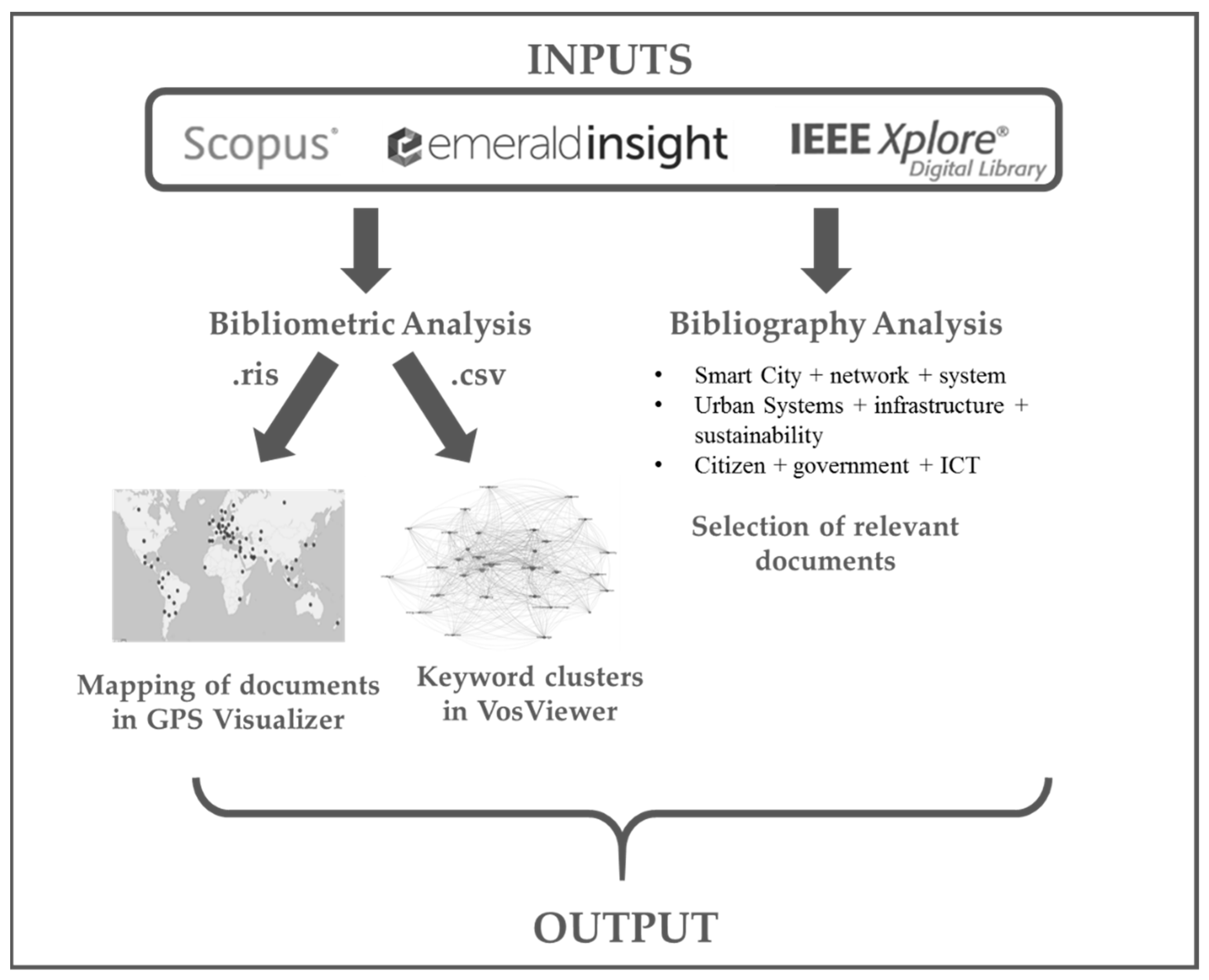
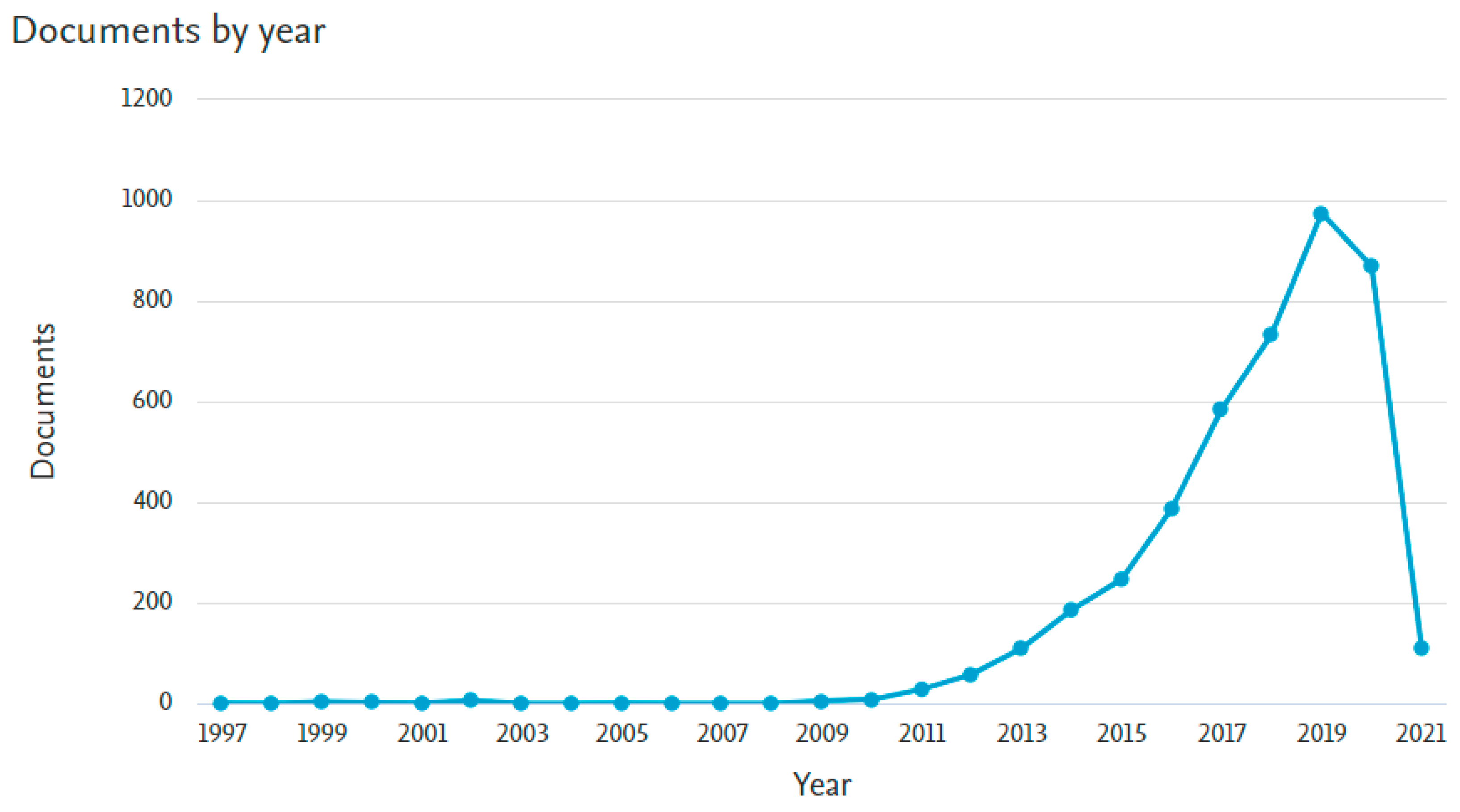
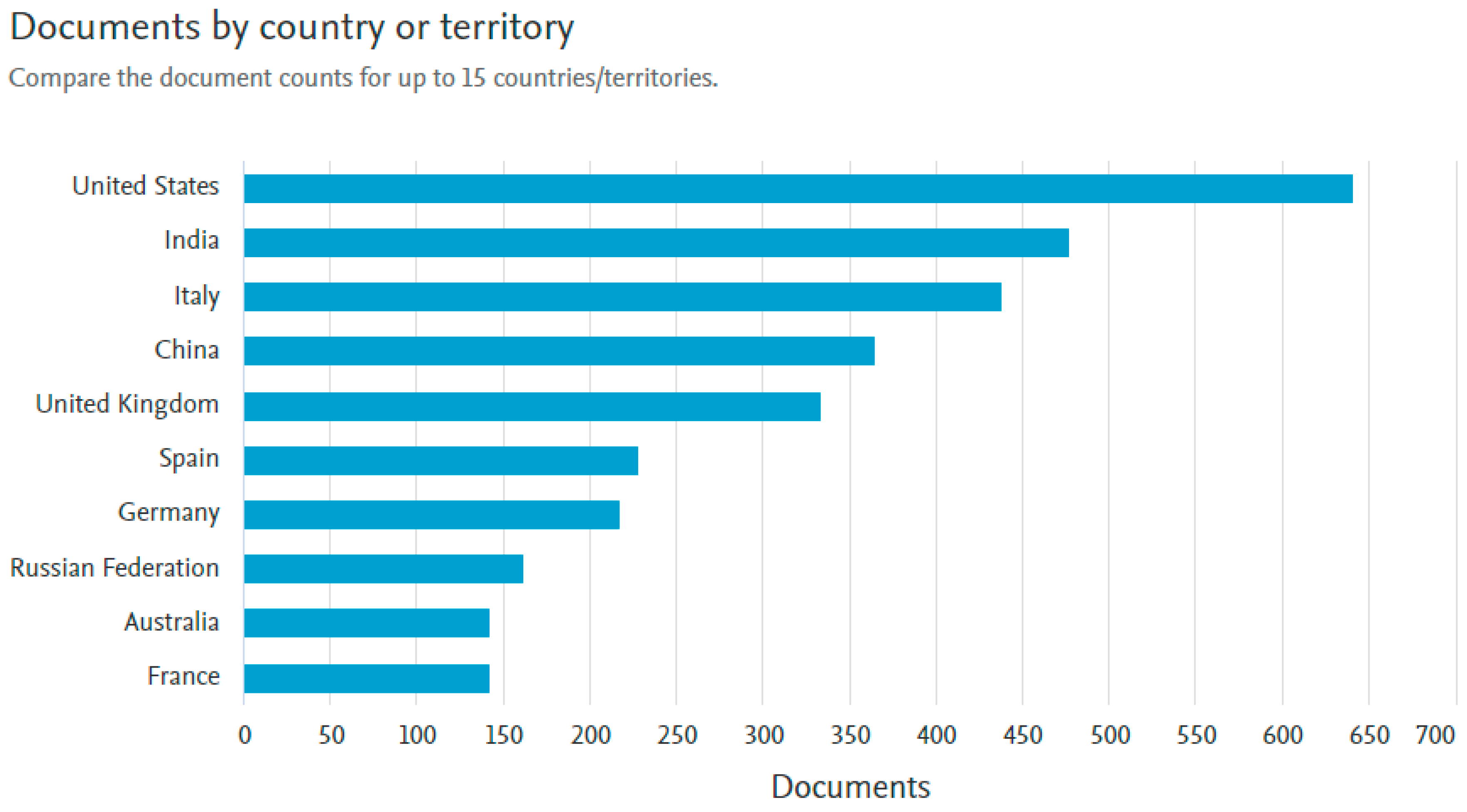
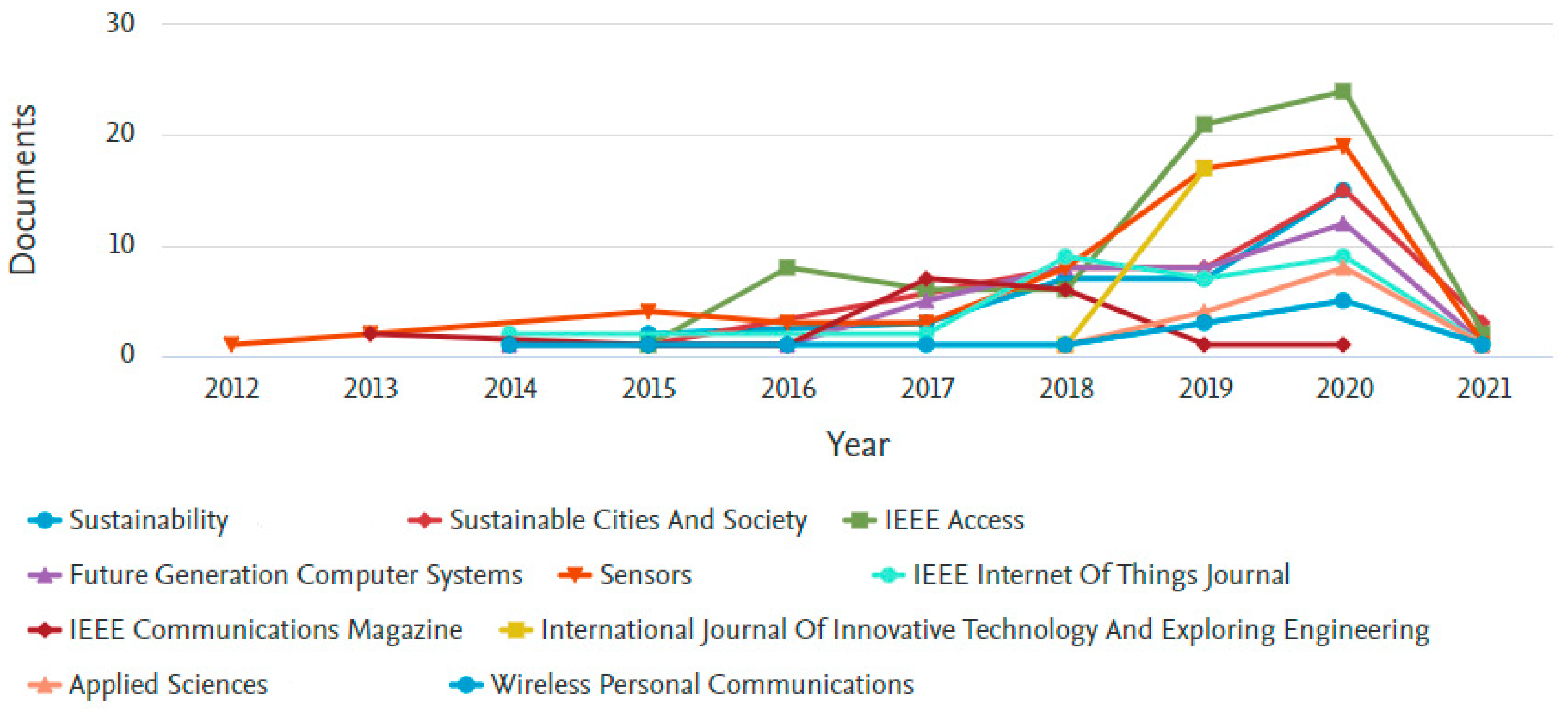
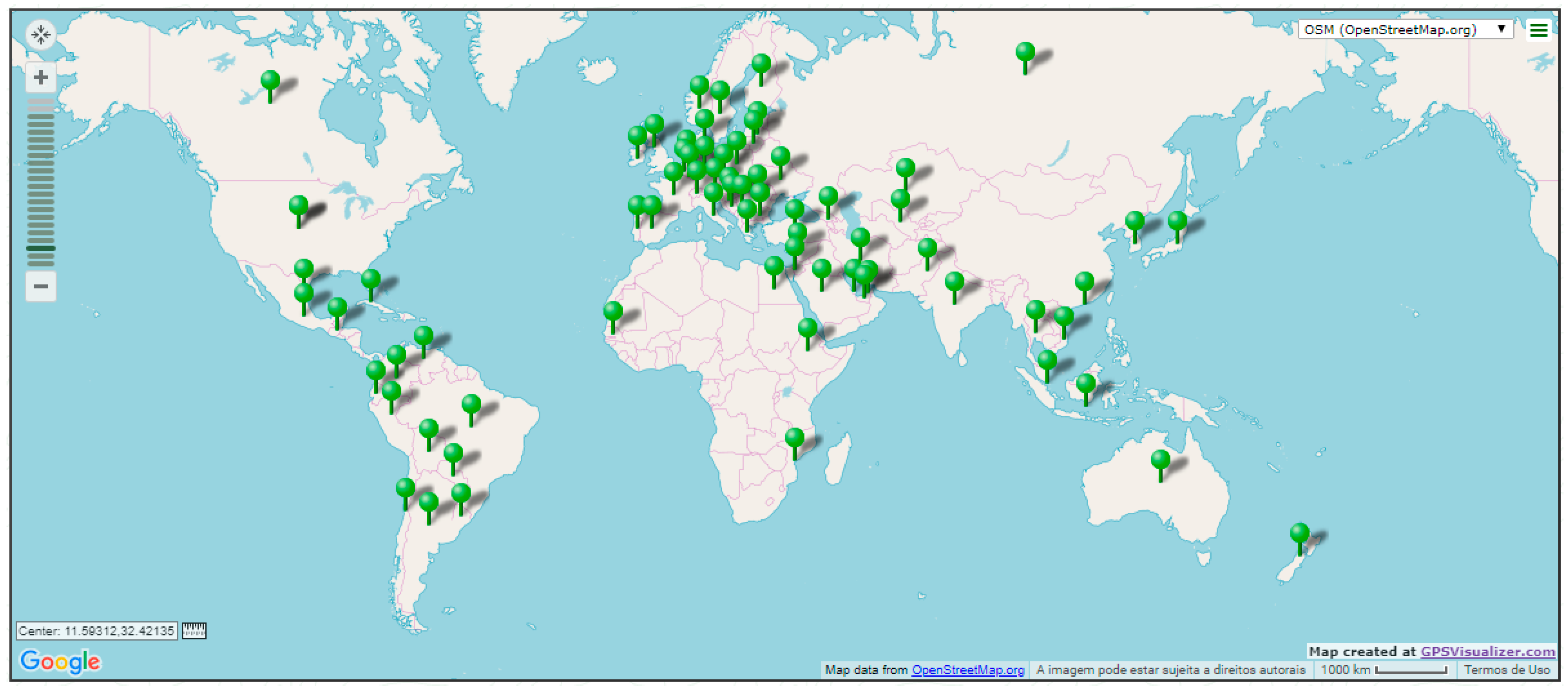
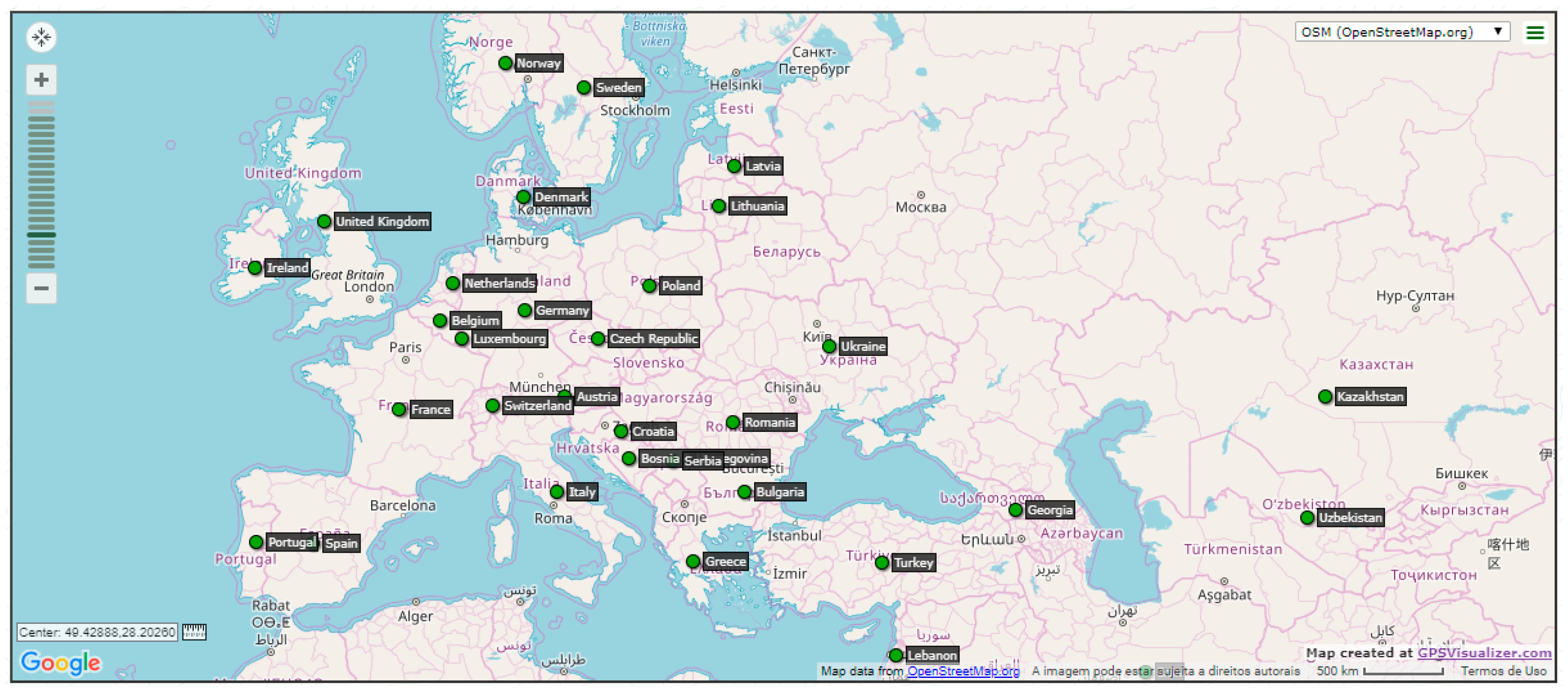

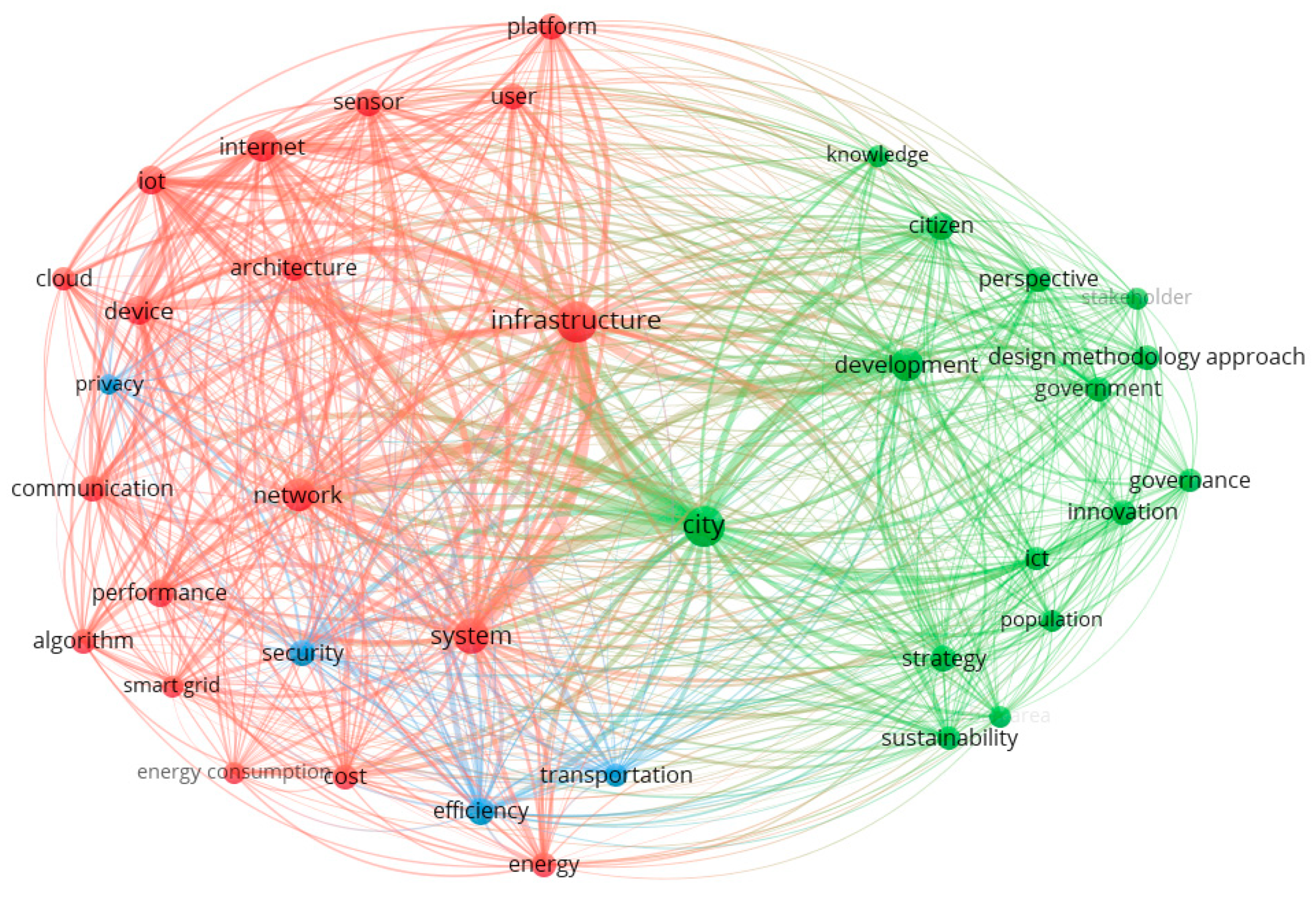
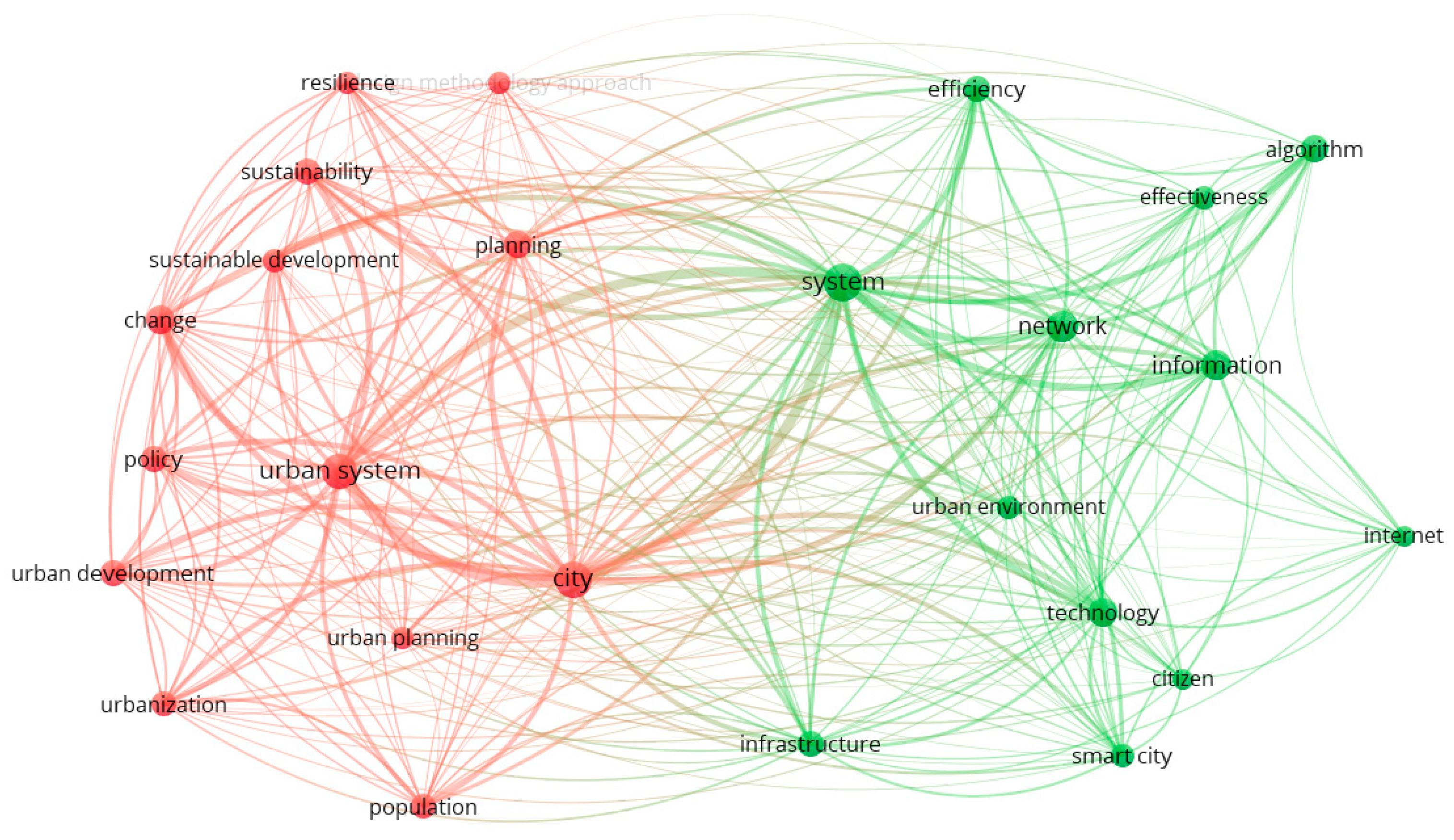
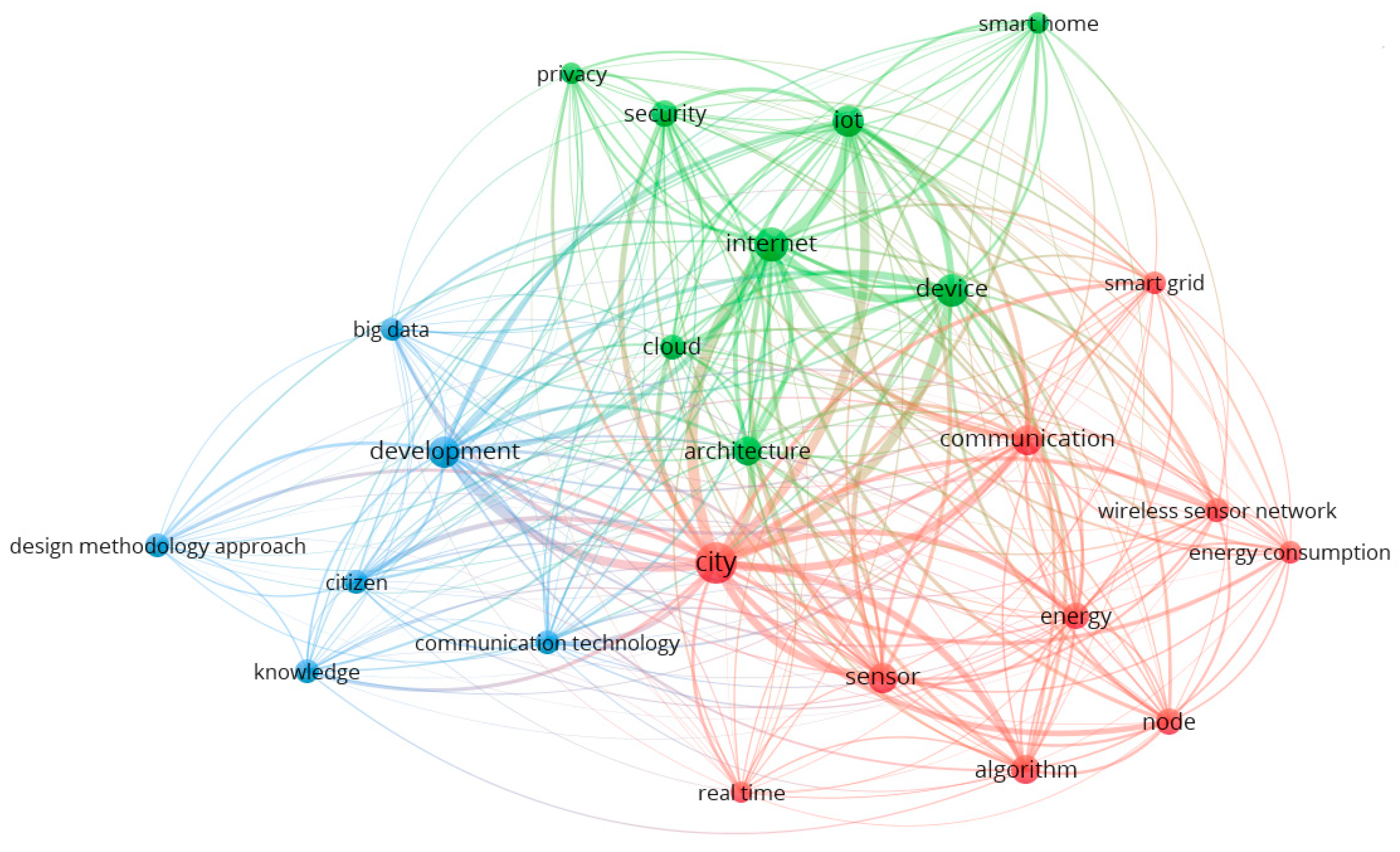
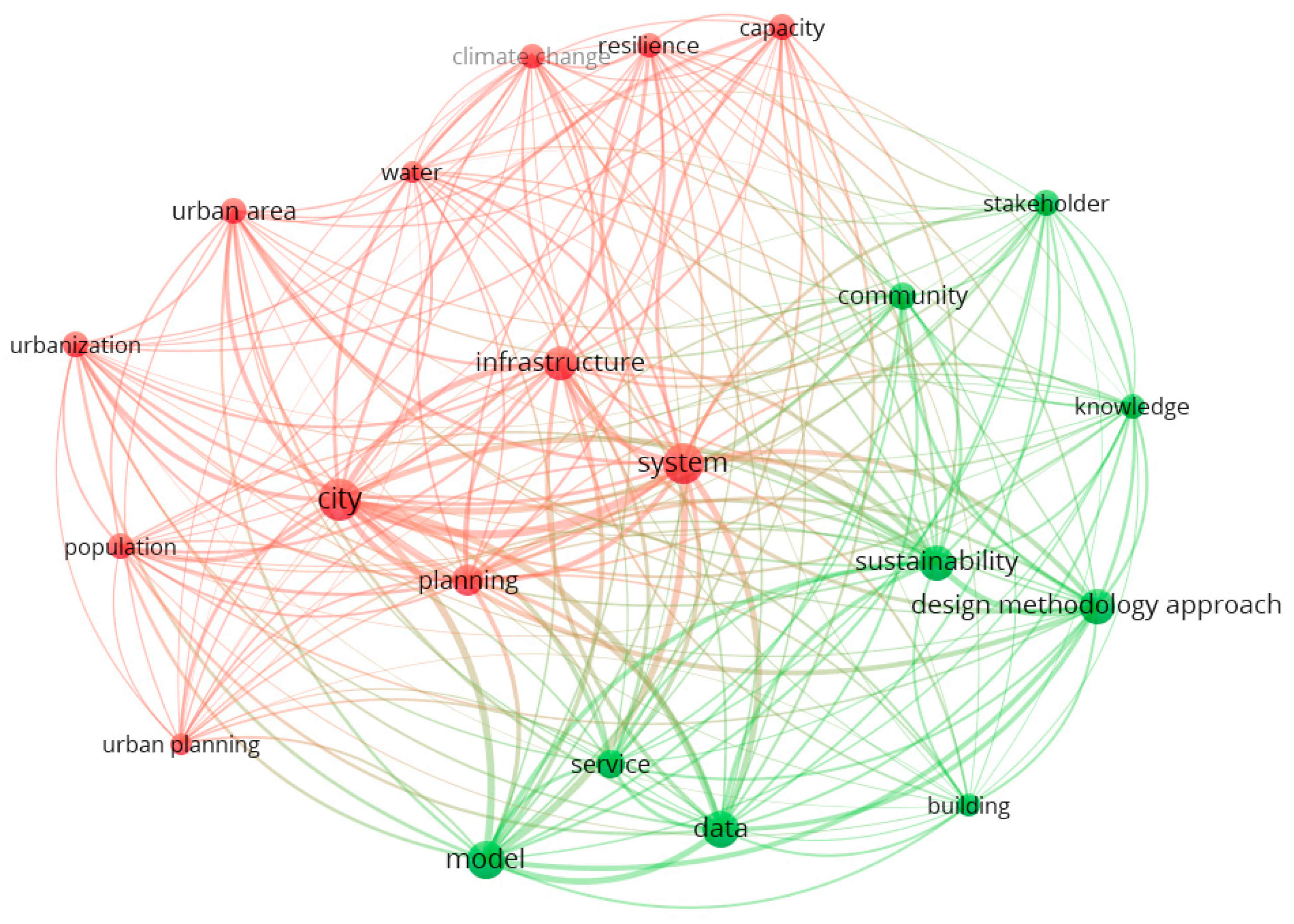
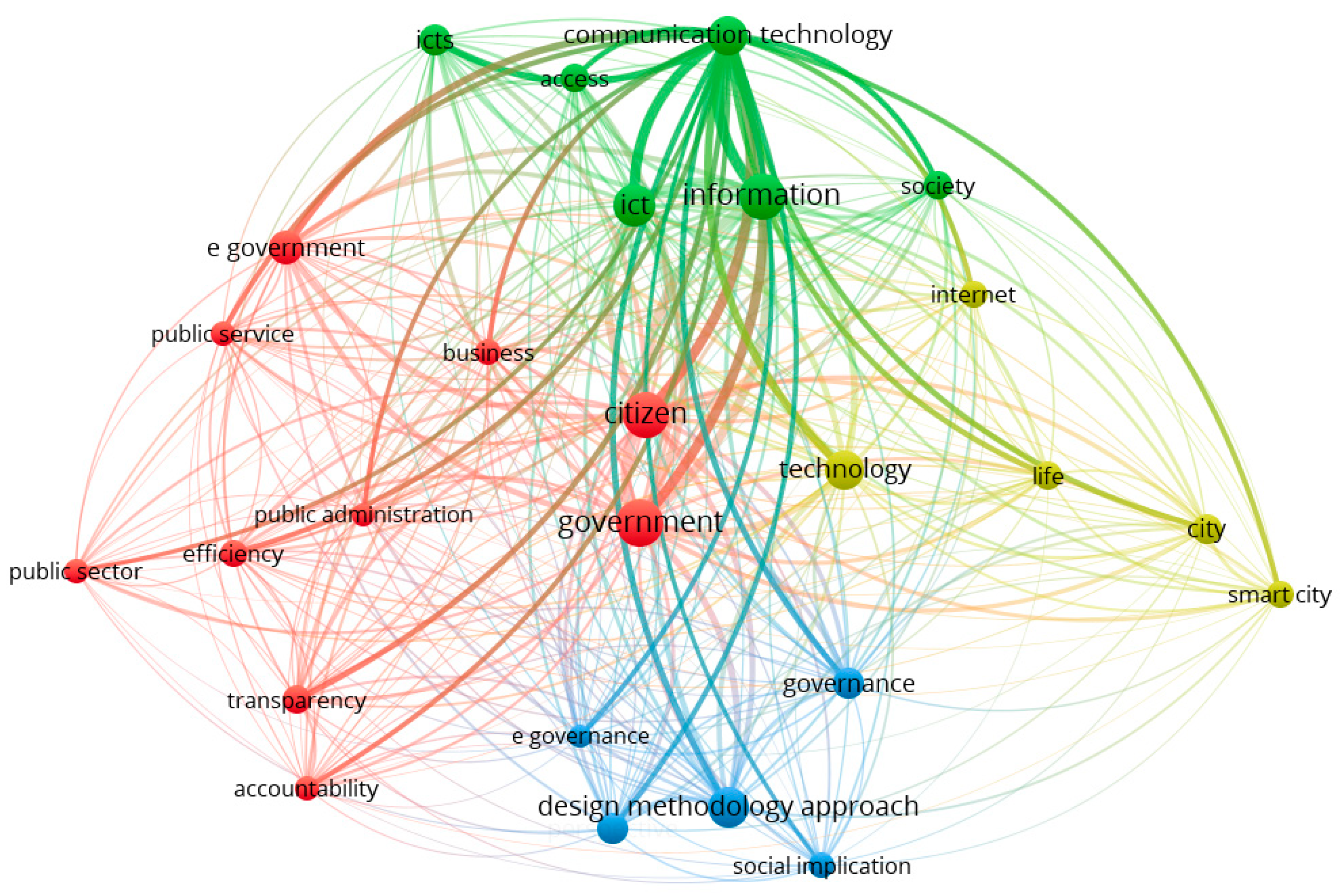
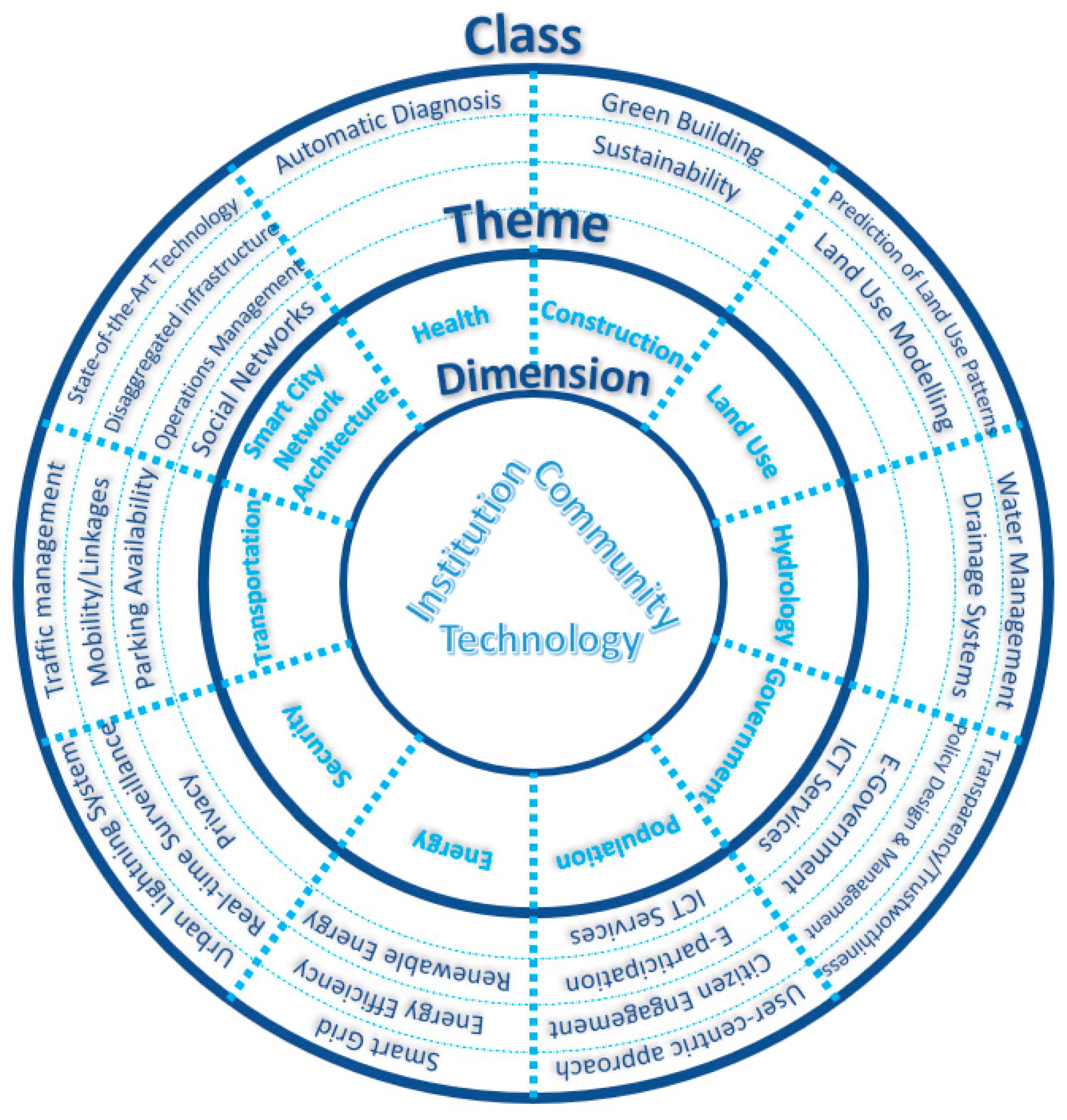
| Database | Number of Articles | ||
|---|---|---|---|
| Group 1 | Group 1 + Group 2 | Group 2 | |
| Scopus Elsevier | 5200 | 834 | 490 |
| IEEE Explorer | 1636 | 291 | 463 |
| Emerald Insight | 286 | 723 | 78 |
| Total | 7122 | 1848 | 1031 |
| Source | Description |
|---|---|
| [17] | Presents a hierarchical architecture to resolve interoperability issues regarding smart energy system infrastructure and services in smart cities. |
| [18] | Proposes a new traffic control system based on the integration of SDN (software defined networks) and IoT (Internet of Things) in the smart city environment in order to ease the movement of emergency service units. |
| [19] | Presents an idea of a traffic management system that helps drivers to reach their destination in optimal time with the use of 5G networks, RFID transponders, and cloud infrastructure. |
| [20] | Applies ANN (Artificial Neural Network) for automatic building detection process, to be applied on smart city infrastructure for lightning detection, in order to build protection. |
| [21] | Presents a security architecture for smart cities where social networks enable an adaptive sensing-as-a-service system. The smart city objects will have their reputation built on the feedback they receive from humans and other nodes in the network. |
| [22] | Discusses the design of information-centric cognitive radio-based networking for multimedia-based applications in smart cities. It also studies its capability for improving network connectivity and content search, distribution, and reliability. |
| [23] | Presents a collaborative experience between government and offering advantages in cloud services to improve the services of smart governments. |
| [24] | Proposes a multilevel IoT-based smart cities’ infrastructure management architecture and evaluates the proposal through a case study related to the waste management problem. |
| [25] | Presents DistArch-SCNet, a new smart city network architecture, to address concerns about energy scalability, flexibility, availability and efficiency in the existing network. |
| [26] | Studies big data algorithms through the lens of the 3 Vs (veracity, volume, and velocity) in order to facilitate soft sensing within smart city applications. |
| [27] | Introduces the smart cities as an important example of sustainable interdependent networks. Moreover, presents the emerging challenges of these networks in terms of upgrading the existent infrastructure to more intelligent systems. |
| [28] | Identifies network characteristics and requirements for different smart city applications. It also identifies networking protocols that can support the data traffic flows between the different components of the system. |
| [29] | Proposes a heterogeneous network scenario to implement a real time video surveillance application in a smart city environment. |
| [30] | Presents a methodological framework for parking availability predictions. |
| [31] | Discusses the concept of a smart city based on ICT (Information and Communication Technology) and analyzes the goals of smart city development in Taiwan. |
| [32] | Proposes a new vehicle network architecture for the smart city environment, mitigating network congestion with the optimization of networking, caching and computing resources all together. |
| [33] | Proposes data-driven methodologies to increase data validity in a cellular network-based transportation data collection system. |
| [34] | Analyzes smart city security architecture and risk, in order to present insights on how to create an optimal smart city security platform. |
| [35] | Proposes an architecture design of green WSNs (wireless sensor networks) for smart cities, also listing the challenging issues raised by its design. |
| [36] | Proposes an energy- and congestion-aware routing metric for smart meter networks to be implemented in smart city scenarios. By minimizing power consumption, network lifetime will be enhanced. |
| [37] | Evaluates a thousand neural network architectures used for the automatic diagnosis of chronic social exclusion. It also presents the advantages of using a DL (deep learning) paradigm over ML (machine learning) alternatives. |
| [38] | Presents tests and experiments to demonstrate the potential of ZnO (zinc oxide) as highly transparent conductive materials and, thus, a suitable and greener alternative to ITO (indium tin oxide) for microwave applications. |
| [39] | Proposes a microgrid-based congestion management method to relieve transmission line congestion. |
| [40] | Presents a comprehensive literature review of key features and applications of the IoT paradigm supporting the sustainable development of smart cities. |
| [41] | Proposes a novel traffic management system by considering the gaps of previous research and what is yet to be explored in the current scenario. |
| Source | Description |
|---|---|
| [42] | Defines the phrase “urban ecological infrastructure” and further proposes an integrated framework in which a city’s infrastructure network provides sustainable urban systems and ecosystem services despite changing landscapes and climate. |
| [43] | Explores the barriers to green infrastructure implementation and suggests policies that can overcome these barriers and accelerate implementation. |
| [44] | Presents a framework for planning and managing urban green infrastructure in order to improve urban sustainability. |
| [45] | Conducts quantitative research on the imbalances of investment in urban infrastructure within China’s cities. |
| [46] | Analyzes the urban infrastructure systems as if they are analogous to ecological systems. Presents the 12 guiding principles of infrastructure ecology and how they can change the decision-making process for urban development. |
| [47] | Examines the potential of big data analytics and context-aware computing to improve urban sustainability. |
| [48] | Documents the challenges and addresses their solutions in the water infrastructure planning and management domain. |
| [49] | Explores the synergy between the sustainable development underway in cities nowadays and the socioecological innovations in the current trend of sharing economy. |
| [50] | Offers strategies for mitigating greenhouse gas emissions from Chinese industrial parks. |
| [51] | Proposes a new economic geography model to simulate China’s urban systems’ evolution and to further predict the future development of the country’s systems under different urbanization prospects. |
| [52] | Presents a geodesign method that facilitates a closed-loop urban system process through algae cultivation by making urban waste streams turn into renewable energy. |
| [53] | Uses an evaluative framework to determine to what extent sustainability initiatives led by local governments reflect what literature claims they can do. |
| [54] | Presents a systems-based framework to define how environmental, organizational and social aspects interact within an urban system in China. |
| [55] | Presents the results of a new indicator system to monitor the environmental quality of infrastructure. The 22-indicator system created accounts for socioeconomic development as well as the construction of sustainable infrastructure, applied to data from 2000 to 2010 in 277 Chinese cities. |
| [56] | Focuses on the debate concerning urban planning, highlighting the need for a novel approach and tools that could allow for the smartization of cities. |
| [57] | Proves that, regarding the whole-city level, the operating cost is intimately related to housing density and relative length of roads. |
| [58] | Examines to what extent urban densification policies contain an assumption that continual growth, expressed in per capita consumption of building stock and infrastructure, should be accommodated. |
| [59] | Examines the outcomes of a collaborative research project, EcoCities, and presents approaches to build adaptive capacity into environmental and spatial planning projects. |
| [60] | Provides an overview of the architecture required in the context of modelling Land Use/Land Cover change patterns. |
| [61] | Presents estimates of the changing exposure of urban infrastructure to floods and droughts due to urban land expansion from 2000 to 2030. |
| [62] | Proposes a stochastic theory of urban growth that considers some scaling; the predictions are confirmed by empirical data from the US and the Organization for Economic Co-operation and Development (OECD). |
| [63] | Proposes a new systemic model approach to the issue of adapting cities to climate change. |
| [64] | Offers a conceptual framework that expands the traditional transition model (industrial-sanitary-sustainable city) to include permutations of transition options. |
| [65] | Uses the multi-sectoral systems analysis tool to address questions of sustainability and to support the decision-making process for policy and investment. |
| [66] | Proposes a system-based framework to synthesize the connections between water use and energy consumption in an urban scenario. |
| [67] | Analyzes how (and to what extent they are indicators) benchmarking and dashboard initiatives are employed by cities, arguing that they make the city seem like visualized facts. It further indicates how this reshapes the way cities are governed. |
| Source | Description |
|---|---|
| [68] | Explores the drivers behind what makes citizens engage in social and political participation on the internet. |
| [69] | Presents a multicriteria methodology to evaluate e-government using eight criteria built on four points of view: infrastructure, investments, e-processes and user attitude. |
| [70] | Develops a new approach to e-participation based on passive crowdsourcing by government agencies. |
| [71] | Discusses the use of government social media for openness and accountability in order to improve citizen participation. |
| [72] | Analyzes practices of citizen involvement in smart city initiatives and to what extent it is the goal of a smart community to involve citizens in governance. |
| [73] | Examines how the use of e-government websites by citizens relates to their satisfaction and perception of public sector trustworthiness. |
| [74] | Proposes a framework that integrates processes, resources, back offices and front offices of online systems for E-Government 2.0 implementation. |
| [75] | Introduces the main features of the Internet-Enabled-Services (IES) Cities platform, whose aim is to facilitate the creation of citizen-centric apps that exploit urban data from different areas of knowledge. |
| [76] | Analyzes the mechanisms through which e-government can influence corruption in a nation and tests the direct and mediated effects of e-government on corruption in national institutions and stakeholder service systems. |
| [77] | Examines the evolution of ICT technology in the public sector throughout time. |
| [78] | Focuses on how to work with imperfections during information retrieval and data integration in a smart city’s systems. |
| [79] | Presents the findings of a survey conducted in Taiwanese cities regarding citizens’ willingness to accept and use ICT services. |
| [80] | Examines how patterns of technological chance in using Geographic Information Systems (GIS) and ICT are impacting local governments’ process efficiency. |
| [81] | Investigates different ways through which open data, together with innovative visualisation techniques, can be used to provide new services to cities. |
| [82] | Provides an integrated model regarding ICT projects that identifies factors that can influence the adoption of e-government services. |
| [83] | Highlights the gaps in current e-government maturity and stage models. |
| [84] | Proposes a multiple-mediation model that examines the technology-organization-environment factors that affect the government’s willingness to implement e-participation. |
| [85] | Develops the concept of ICT as an influencer of how citizens view civic roles by testing relationships between social media use, political identity, and citizens’ views of government service provision and spending. |
| [86] | Proposes a practical framework structure to organize, promote and implement e-participation. |
| [87] | Presents and examines the effects on service delivery outcomes of a novel ICT platform where citizens can send free and anonymous messages to the local government. |
| [88] | Examines the key determinants of mobile government attractiveness. |
| [89] | Determines the criteria important for both teachers and citizens in using video-to-video (V2V) communication in municipality services for ICT education of senior citizens. |
| [90] | Proposes a conceptual framework for e-government implementation in a low infrastructure situation. |
| [91] | Presents a checklist for use by designers and city planners to identify key outcomes of a user-centric mobile initiative from the government. |
| [92] | Presents the outcomes of a survey regarding data collection in Iran, including aspects of technical and communication infrastructure, business environment, culture, and society. |
| [93] | Analyzes the development of the digitalization process of the Italian Public Administration, through the adoption of well-suited ICT solutions. |
| Dimensions | Frequent Subjects | References |
|---|---|---|
| Technology | AI | [13,101,102,103] |
| Traffic Real-time control | [104] | |
| Sensor network | [105] | |
| RFID technology | [106] | |
| 5G | [107] | |
| IoT | [102,108,109,110] | |
| Big Data | [111] | |
| Institution | E-governance | [112,113] |
| ICT services | [103,114,115] | |
| Community | E-participation | [102,116] |
| ICT services with a user-centric approach | [117] |
| Themes | Classes | Articles |
|---|---|---|
| Energy | Smart Grid | [17,66] |
| Energy Efficiency | [35,36] | |
| Renewable Energy | [50] | |
| Security | Privacy | [34] |
| Urban Lighting System | [20,57] | |
| Real-time Surveillance | [29] | |
| Transportation | Traffic management | [18,19,33,36,39,41] |
| Mobility/Linkages | [45,62] | |
| Parking Availability | [30] | |
| Smart City Network Architecture | State-of-the-Art Technology | [25,26,31,32,40,47,93,118] |
| Social Networks | [21,22] | |
| Operations Management | [27,28,38,51,67,78] | |
| Disaggregated infrastructure | [119,120,121,122,123] | |
| Health | Automatic Diagnosis | [37] |
| Construction | Green Building | [42,43,44] |
| Sustainability | [46,47,49,124] | |
| Land Use | Prediction of Land Use Patterns | [60,61,64] |
| Land Use Modelling | [56,59] | |
| Hydrology | Water Management | [48,52,66] |
| Drainage Systems | [61,125] | |
| Government | Transparency/Trustworthiness | [53,71,73,76] |
| E-Government | [73,83,84,90,93,126] | |
| ICT Services | [70,71,76,77] | |
| Policy Design and Management | [58,65,80] | |
| Population | User-centric approach | [75,91] |
| ICT Services | [68,81,85,87,89,92] | |
| Citizen Engagement/E-participation | [68,81,100,116] |
Publisher’s Note: MDPI stays neutral with regard to jurisdictional claims in published maps and institutional affiliations. |
© 2021 by the authors. Licensee MDPI, Basel, Switzerland. This article is an open access article distributed under the terms and conditions of the Creative Commons Attribution (CC BY) license (http://creativecommons.org/licenses/by/4.0/).
Share and Cite
Kasznar, A.P.P.; Hammad, A.W.A.; Najjar, M.; Linhares Qualharini, E.; Figueiredo, K.; Soares, C.A.P.; Haddad, A.N. Multiple Dimensions of Smart Cities’ Infrastructure: A Review. Buildings 2021, 11, 73. https://doi.org/10.3390/buildings11020073
Kasznar APP, Hammad AWA, Najjar M, Linhares Qualharini E, Figueiredo K, Soares CAP, Haddad AN. Multiple Dimensions of Smart Cities’ Infrastructure: A Review. Buildings. 2021; 11(2):73. https://doi.org/10.3390/buildings11020073
Chicago/Turabian StyleKasznar, Ana Paula P., Ahmed W. A. Hammad, Mohammad Najjar, Eduardo Linhares Qualharini, Karoline Figueiredo, Carlos Alberto Pereira Soares, and Assed N. Haddad. 2021. "Multiple Dimensions of Smart Cities’ Infrastructure: A Review" Buildings 11, no. 2: 73. https://doi.org/10.3390/buildings11020073
APA StyleKasznar, A. P. P., Hammad, A. W. A., Najjar, M., Linhares Qualharini, E., Figueiredo, K., Soares, C. A. P., & Haddad, A. N. (2021). Multiple Dimensions of Smart Cities’ Infrastructure: A Review. Buildings, 11(2), 73. https://doi.org/10.3390/buildings11020073










